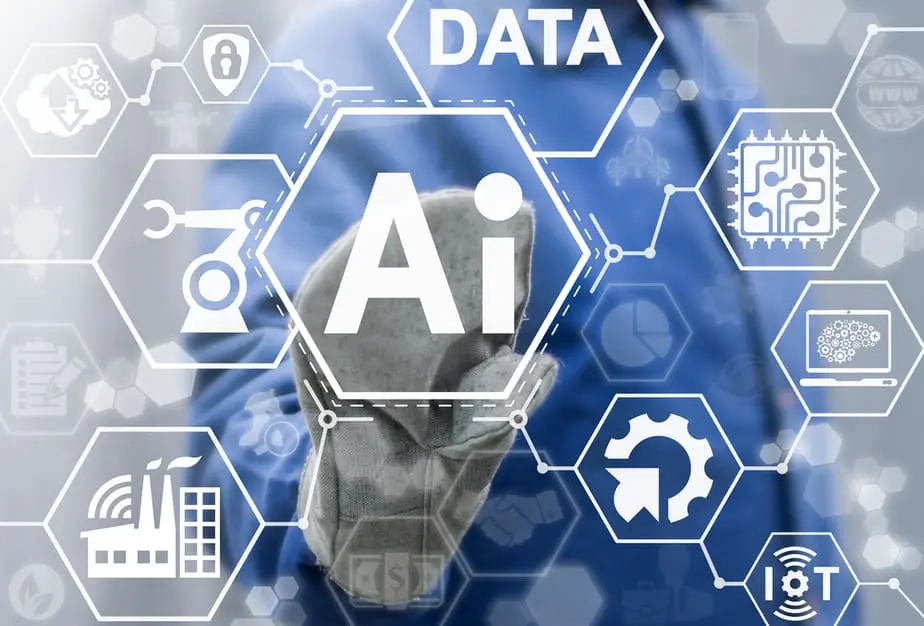Editor's Note: This post is republished with permission from an article by George Stenitzer.
“How will AI (artificial intelligence) change marketing?”
At the first-ever Marketing Artificial Intelligence Conference (MAICON), thought leaders showed marketers what’s coming.
“Most marketers don’t know what is AI or how to use it,” says Paul Roetzer, the founder of MAICON.
AI is all about smarter machines enabling humans to do smarter marketing.

Are you an AI skeptic or believer?
Pioneers who bring AI into marketing usually hit a wall of skepticism.
If you’re starting out skeptical about AI in marketing, so did I. A while ago, I was an AI skeptic, despite the fact that I’d:
- Started to learn about AI in marketing from Christopher S. Penn of Trust Insights, an AI evangelist, thought leader and author.
- Written a blog “Is AI Ready for Marketing? Are Marketers Ready for AI?”
- Used AI to get a big job done that humans could not do – an AI pilot project I’ll share at Content Marketing World 2019.
Now I’m a believer. But many marketers aren’t.
“The skepticism about AI inside companies is healthy, yet surprising,” says Sara Hocking, Marketing Innovation Associate Director at Grant Thornton.
“Surprise! At first, people trust Excel more than AI!” says Kanishka Bhattacharya of Publicis Sapient. “On AI, everyone needs to educate themselves. Keep learning!”
Will AI replace marketers?
My take? No.
“AI won’t eliminate jobs. It will eliminate tasks,” says Penn. “So, if your job is only one task, watch out. Become multi-disciplinary to be hard to replace.”
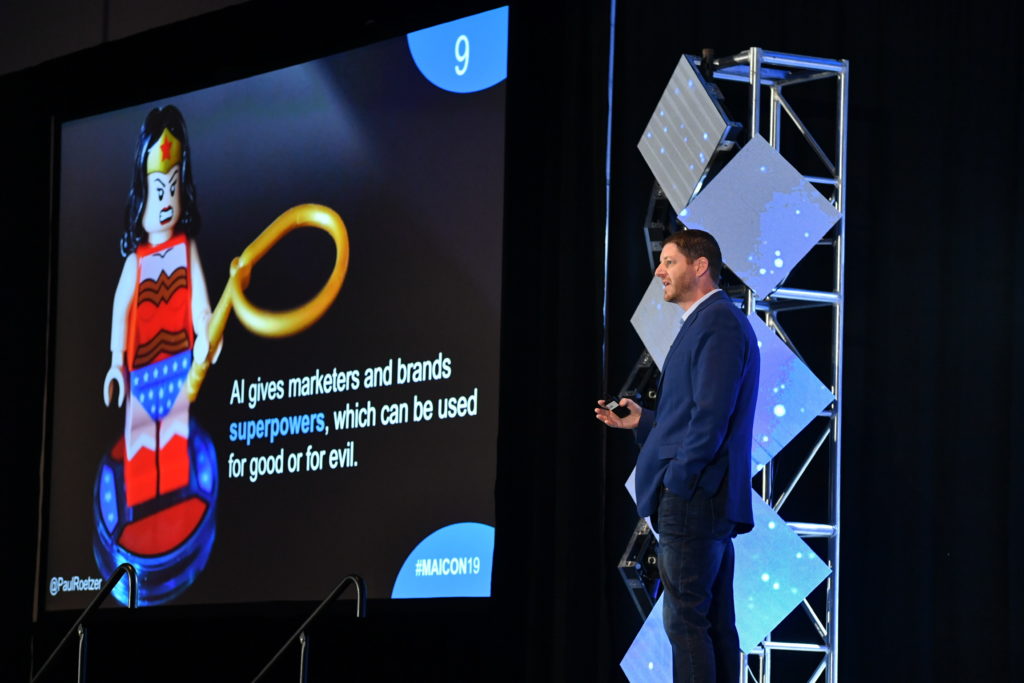
How to evolve from AI skeptic to believer?
How to get going in AI? Learn all you can about AI, its marketing use cases, where to start, and how to overcome the inevitable obstacles.
To get a handle on AI in marketing, address these key questions:
- What is AI (artificial intelligence)?
- How to get started on AI?
- Can AI do marketing jobs?
- What are the top 7 AI marketing use cases?
- What AI obstacles need to be overcome?
- How to strike the right balance of human and AI in marketing?
You’ll find answers to these questions below.
What is AI, anyway?
Roetzer offers a definition of AI from Demis Hassabis of DeepMind AI: “AI is the science of making machines smart.”
“AI is getting machines to do human-like tasks,” says Penn. “Take data, train the machine, learn from it.
“AI is math. Not magic. We’re not trying to replace humans but to empower them.”

Karen Hao, AI reporter at the MIT Technology Review, puts it this way: “AI mimics human sight, hearing, writing, reasoning.
“What is AI today? The reality is machine learning, mostly. The dream is to solve global challenges to help us live better lives.”
Yet today, “AI is not as smart as a 2-year-old.”
In the diagram below, Hao sees 2 branches of AI: one based on knowledge, another on learning.
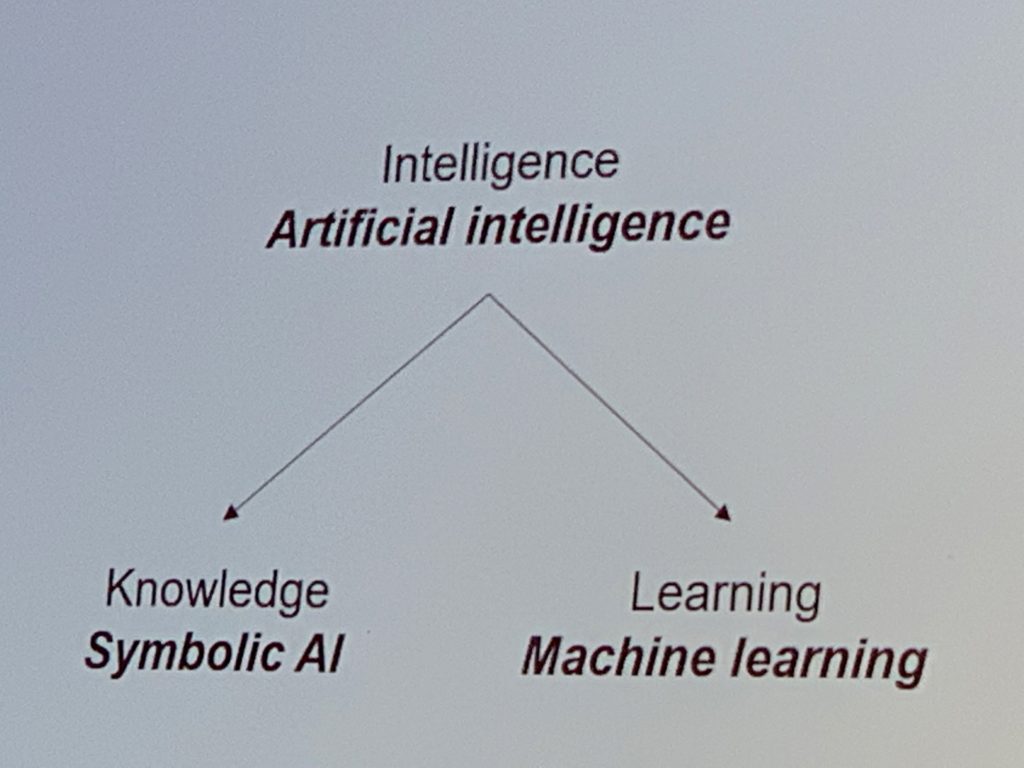
of MIT Technology Review .
Which begs the question: what is intelligence?
“Intelligence is about the ability to recognize patterns,” answers author and futurist Nikos Acuña. AI finds the patterns in data sets that are too big for people to process.
How to get started on AI?
“Start small. Prioritize pilot AI use cases,” says Penn.
Where should you begin? Hocking shared insights from her experience of introducing AI at Grant Thornton.
“Train people to understand what AI can do so they recognize use cases,” Hocking says. Tap AI vendors as a resource to educate the marketing team.
“Research AI vendors who address gaps in your firm. Have them give educational demos. Ask: ‘How is this different? How is this better?’”
Then “Do a brainstorm. Have the team come up with AI use cases.”
To use AI effectively, first you need to find a business problem it can solve.
“Find a use case. If you haven’t identified the problem, people will not use it,” Hocking says. “To score AI use cases: consider business value, readiness and strategic value.”
Build or buy AI?
“Should you build or buy AI? If you have time, build it. If you have money, buy it,” Penn says.
“For quick-win AI pilot projects, find a vendor,” Roetzer adds.
Can AI do marketing jobs?
AI already does many kinds of different jobs, says Katie Robbert of Trust Insights:
- Image recognition: face recognition, cancer diagnosis, self-driving cars
- Speech recognition: transcription, voice assistants, voice identification
- Text prediction: autocorrect, autocomplete
- Ranking systems: search on Google, news feed on Facebook
- Recommender systems: shows on Netflix, music on Spotify, videos on YouTube, products on Amazon, targeted ads.
In marketing, “AI does 2 jobs. It reduces cost by intelligently automating repetitive tasks. And it drives revenue by improving your ability to make predictions,” says Roetzer.
With AI, you “Get more out of your data. Discover insights, predict outcomes, devise strategies,” he adds.
As Acuña sees it, AI benefits companies by playing 3 roles: “Drive business performance. Provide transparent insights. Deliver remarkable customer experiences.”
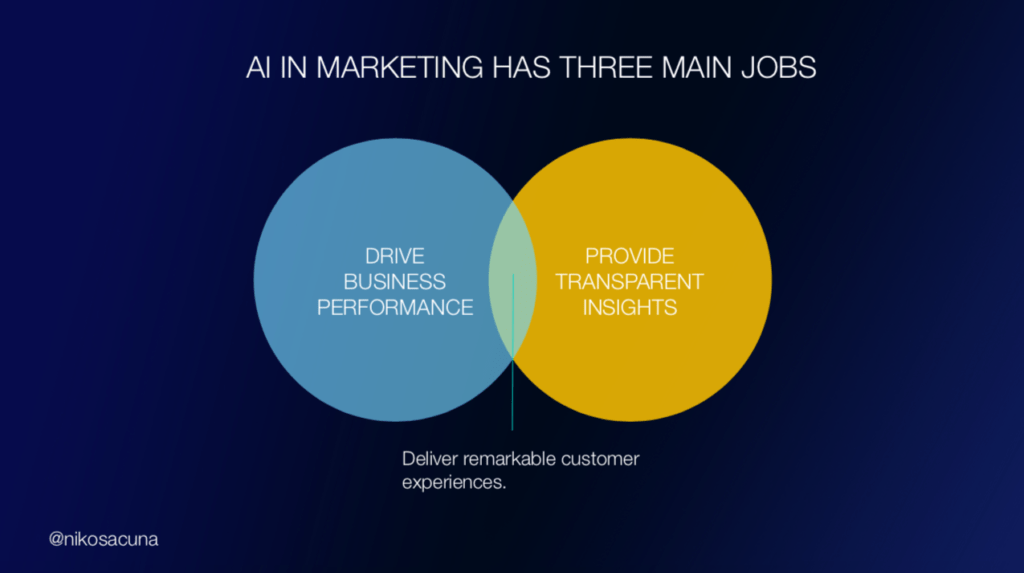
What are AI marketing use cases?
Here are 7 uses cases for AI in marketing, plus a couple of bonus use cases for B2B marketers.
Use case #1: Use data to settle debates quickly – “Instead of 2 months of debate, use AI to process data in minutes,” advises Penn.
That reminds me of Andy Crestodina’s longstanding advice, “Never bring an opinion to a data fight.”
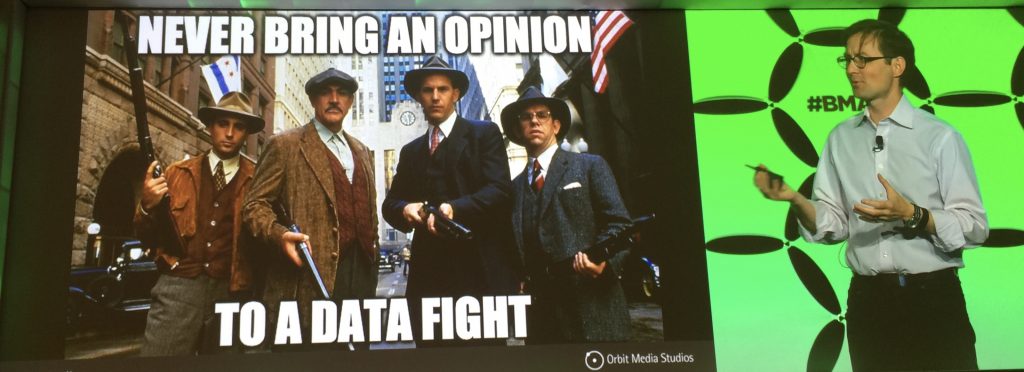
It’s crucial to measure the right data. For example: “The right measure of influence is: Who’s most talked about?” Penn says. “Not: Who has the biggest mouth?”
Walking his talk, Penn created this Trust Insights’ interactive map of who was most talked about at MAICON – and shared it on the last day of the conference.
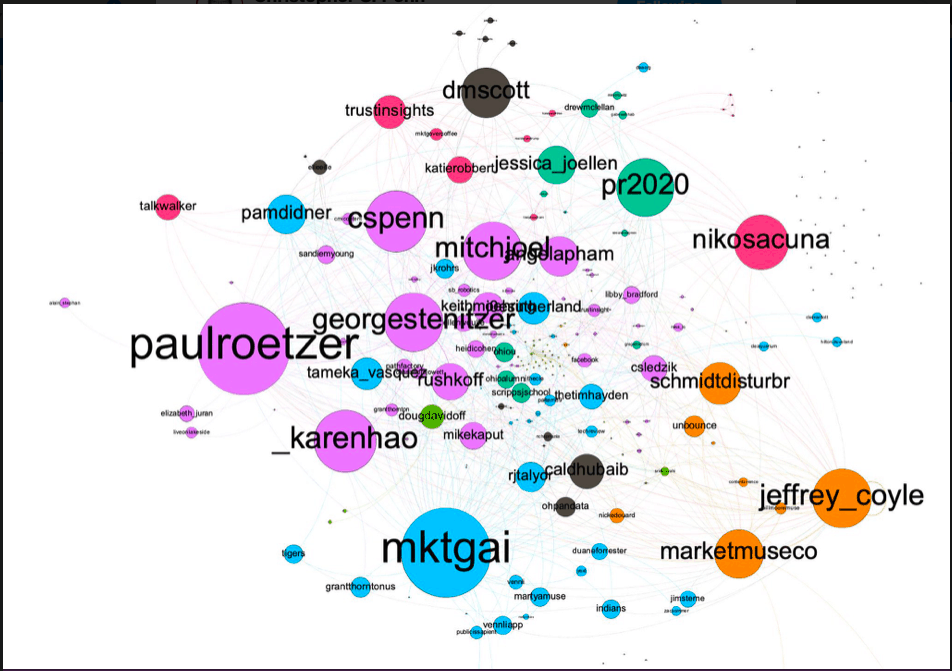
Use case #2: Prepare for voice search – Mitch Joel of Six Pixels focuses on the incoming tidal wave of voice search.
“Voice is the gateway for all technologies, the remote control for our lives. Voice is the new smartphone,” Joel says. Yet, “There is no killer app of voice activated assistants.”
How many voice assistants are in use? Joel shared a Juniper Research forecast that shows voice assistants more than doubling from 3.25 billion this year to 8 billion in 2023.
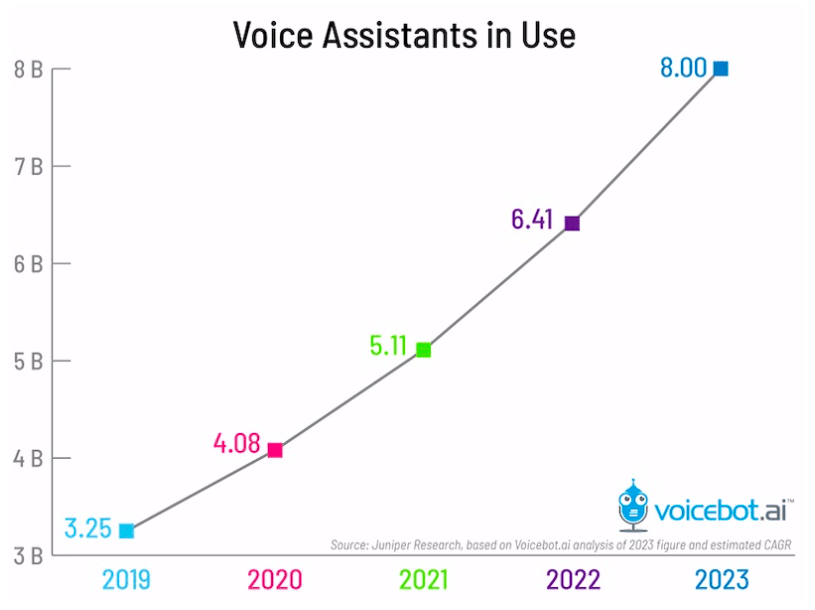
“Brand voice is at an inflection point: everyone will have to have a ‘voice brand,’” Joel says. “30% of all searches will be done without a screen by next year. What people say is different from what they type.
“45% of millennials use voice assistance while shopping. People who shop with voice assistance spend more. It’s even less friction than one-click.”
Voice will make its place(s) in people’s lives. “Think about voice not only as devices. Think about the spaces occupied — kitchens, common areas of a house,” Joel says. “You can put Alexa in your car for $25, in your microwave for $50.
“Today 10,000 people are working on Alexa alone.” Alexa already has 60,000 skills, he adds.
Voice applications will get more and more granular. “The connected home will lead to the connected self.” For example:
- Arthritis sufferers love voice assistants. No tiny keyboards to struggle with!
- Hearing aids will get voice assistants.
Use case #3: Ensure content completeness – “Does your content cover all the dimensions that people are looking for?” asks Jeff Coyle of MarketMuse. “Build the content foundation before you try to rank for a particular search.”
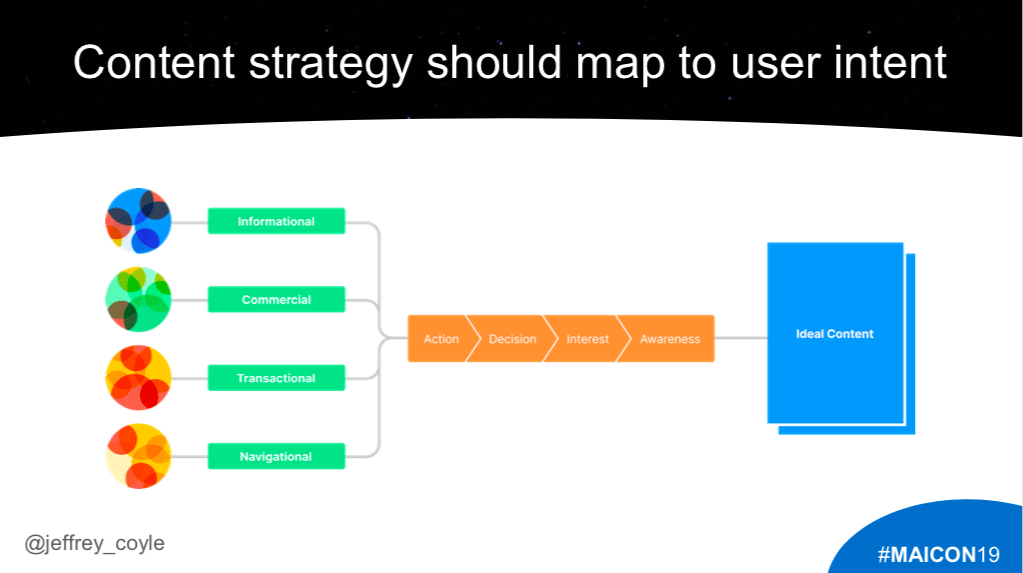
“Use AI to address editorial blind spots.
“Identify poor quality early, improve topic coverage and compare to competitors’ content before you publish … AI can even show which customer questions are not answered,” Coyle adds.
“It doesn’t pay to focus on keywords. Think of the potential content can create, not just the search volume. Assess content clusters for quick wins.”
Make sure your buyer finds all the content that’s relevant to a topic, such as this one:
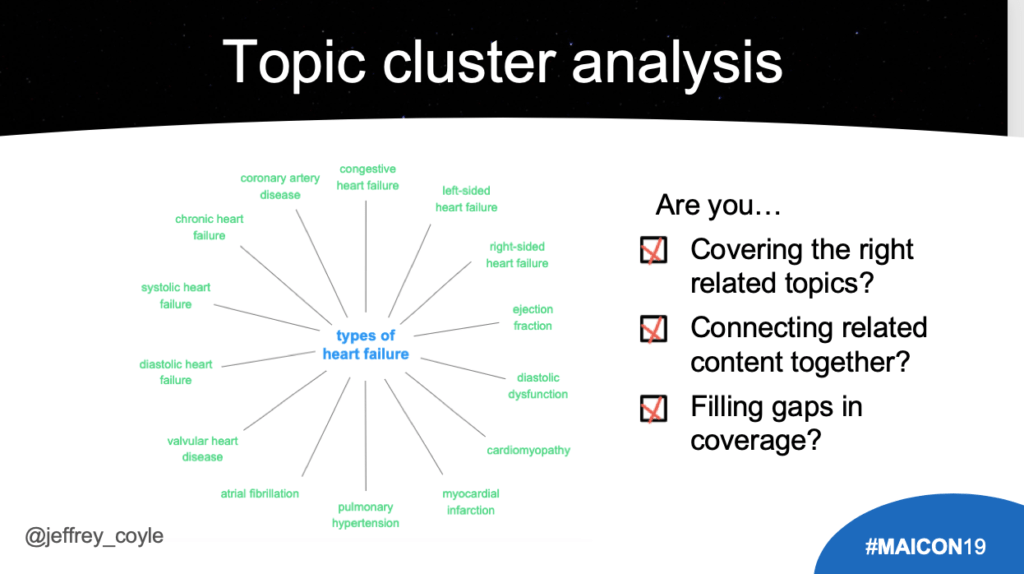
Use predictive analytics: “Predictive analytics are what Nostradamus and the Farmer’s Almanac tried to do,” Robbert says. AI sharpens the human ability to predict the future.
But predictive analytics are evolving quickly, following this progression:
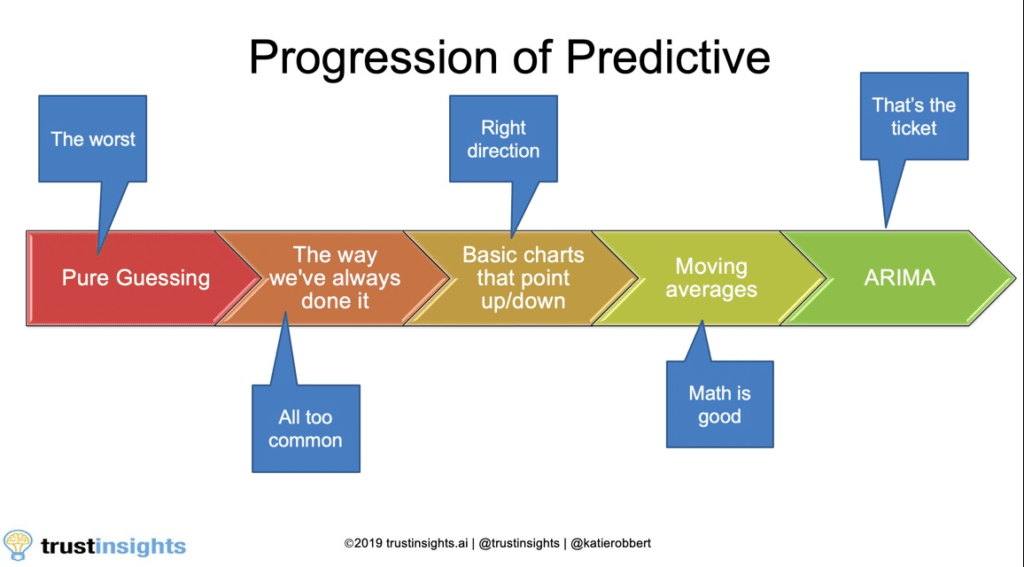
Best and worst weeks to send emails
She offered an example of predictive analytics that’s a quick win for marketers. Trust Insights uses AI to forecast the best and worst weeks to send an email in the next 12 months.
Best weeks to send an email, by quarter:
- September 15, 2019
- October 20, 2019
- January 12, 2020
- April 26, 2020.
Worst weeks to send an email, by quarter:
- August 11, 2019
- December 15, 2019
- March 29, 2020
- May 17, 2020.
The forecast is based on Google searches for how to set up an out-of-office email.
“The best analogy to AI is maps,” Roetzer says. “AI predicts the fastest path from A to B to C. Let AI make a prediction, then go.”
Use case #5: Chat bots – Angela Pham of Facebook works on a team that provides short responses to people’s posts. For example, here’s how people respond to vacation photos on Facebook:

In this case, people’s responses are predictable enough that bots can reduce friction for users. “Who is a bot and who isn’t is hard to tell,” Pham says.
As you work with bots, “Build with care,” Pham advises. Always ask:
- Who’s doing the talking?
- What are we helping people do better? Be crystal-clear about the problem to be solved.
- What are our language principles? Formal or informal, supportive or snarky?
- How do we serve the world, not a subset? Consider diversity and inclusion.
- How do we build the experiences if we’re not building the products?
Use case #6: Natural language generation (NLG) – “Creating content by robot works best for formulaic stories like sports and financial news,” says Cassandra Jowett of PathFactory.
Keith Moehring of agency PR 20/20 describes NLG as “Mad Libs meets Choose Your Own Adventure.”
PR 20/20 uses NLG to report monthly results to clients. Instead of taking 5 hours per report, AI compiles reports in minutes. Clients receive reports much sooner – on the 1st of the month, not the 15th.
The keys to NLG success are to evaluate NLG opportunities, templatize your content, and start small and simple. Make spreadsheets that have clear, unique labels for each type of data.
Marketers can produce these types of deliverables by using NLG:
- Curated content
- Earnings reports
- Emails
- Industry trend reports
- Machine translation
- News analysis
- News releases
- Product descriptions
- Real estate property descriptions
- Reports
- Social shares
- Weather forecasts
- Weekly recaps.
Automated Insights is an NLG that writes news stories for the Associated Press (AP). A similar product is Quill from Narrative Science.
Or build your own natural language generator.
Use case #7: Product forecasting – At the leading edge of use cases in marketing AI, “A global car manufacturer is looking at web behavior to forecast which parts to buy, which cars to build,” says Bhattacharya.
What are B2B marketing AI use cases?
Since B2B buying can be more complex than B2C, more use cases spring up. Elle Woulfe of PathFactory showed this chart on complex buying processes.

In B2B marketing today, “Content personalization is #1 application of AI in B2B services marketing,” says Robbert.
“Stop marketing. Start enabling buyers,” Jowett says. “The marketing problem isn’t that buyers need more content. They need the right content.”
“B2B marketers’ job is to help buyers buy. Focus on buyer enablement. Buyers want a personalized, frictionless experience,” Jowett adds.
Jowett recommends these AI B2B use cases:
- Enable self-service on your website. Create a personalized resource center (instead of a dumping ground for older content).
- Always-on nurturing. Feed buyers who are on a content binge.
- Turn a dead end into a next step.
“B2B buyers have become radically consumerized. Reduce friction for buyers. Make content easy to find and use,” says Woulfe.
She asks, “Do people spend a lot of time with your content? Do you know which content they like? Enable behavioral personalization.
“Create a personal TV channel of content for each buyer. The buyer shows up and gets what they’re looking for, and knows what to do next,” Woulfe says. “A smart personalized resource center even lets buyers pick up where they left off. Like Netflix.”
For example, here’s the “Steve channel”:
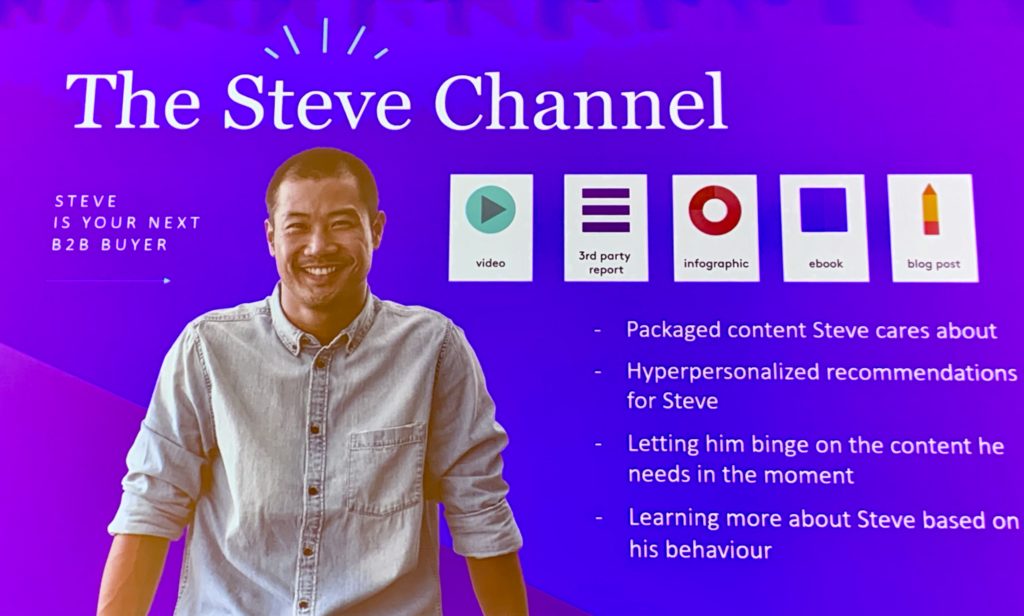
What AI can’t do
AI can’t do every marketing job. Don’t ask AI to multitask or do what humans do best.
“AI systems today are each good at one thing. Not at multiple things,” says Hao.
“AI is bad at empathy, judgment, general life experience, and relationships,” says Penn.
How to balance humans and AI in marketing?
Striking the right balance between humans and machines is an age-old problem.
Consider this quote:
“Automation is not our enemy. Our enemies are ignorance, indifference and inertia. Automation can be the ally of our prosperity if we will just look ahead.”
President Lyndon Johnson, 1964
To get the most of AI, “Make marketing decisions by combining the power of AI with human judgment,” Woulfe says.
Here’s a decision model that Woulfe shared:
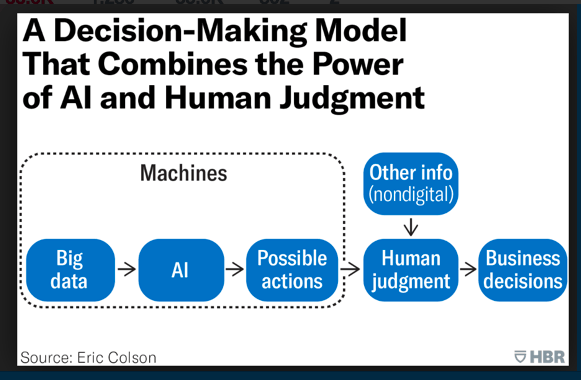
from Eric Colson in Harvard Business Review.
My partner Ariana Nikitas, who worked with Watson at IBM, puts it this way: “AI recommends. People decide.”
Humans remain essential
Author David Meerman Scott shared an example: 50 years ago, when the Apollo 11 guidance computer overloaded, humans had to take over to land on the Moon.
Scott shared a current example of what happens if the human element gets lost in marketing – from the current crop of Presidential candidates. If there’s too little human oversight, it’s way too easy to make marketing too robotic!
Scott contrasted the different approaches taken by Democratic candidates for President. Democratic candidates Julian Castro, Joe Biden, Kamala Harris, and Cory Booker use the exact same AI robot to issue event tickets, Scott found. Here are event texts they sent:
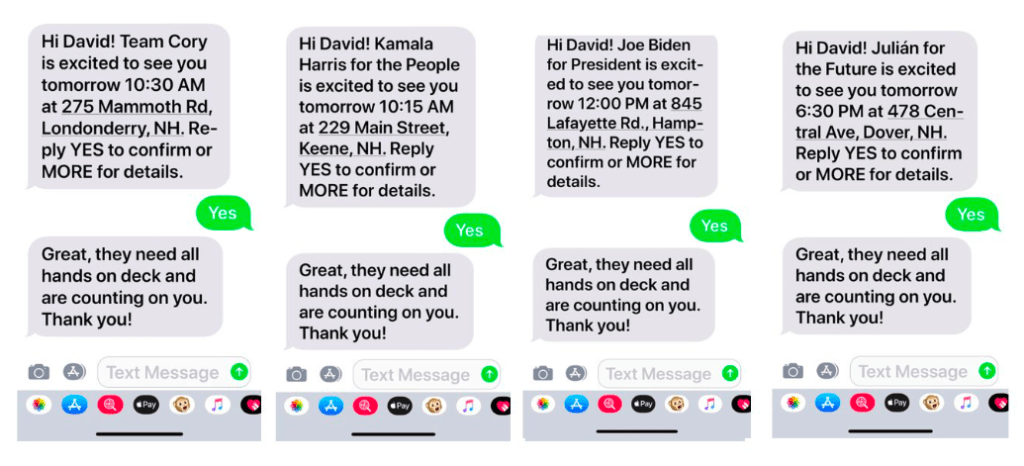
Absolutely identical, absolutely robotic!
Human inattention by other candidates made it easy for Elizabeth Warren to come across as more human with her event ticket featuring her dog Bailey:
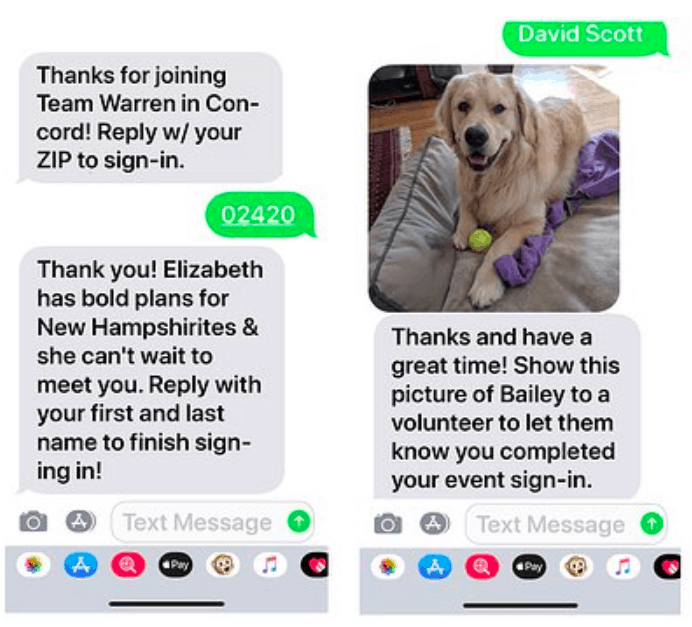
These examples show how crucial it is to maintain the right balance of human and AI work. For more insights on the Presidential campaign trail, here’s a Scott blog, “What Marketers Can Learn From 2020 Presidential Candidates’ Text Messaging.”
“If you’re doing something a robot can do, it’s probably not the best use of your time,” says Tameka Vasquez of Genpact. “AI is best for routine, complex data tasks. Marketers are best for judgment, expertise, and innovation.”
“Don’t compete with machines. Complement them,” says Mike Kaput of PR 20/20.
“If the task is data intensive, repetitive and involves prediction, AI excels at it. If it’s creative, strategic and empathetic, put humans on it.”
How to decide what a robot should do or not do?
Getting the human-AI balance wrong is a major risk. “Should we use historical data in lieu of human creativity, we’re doomed to repeat history,” says Team Human author Douglas Rushkoff.
“Given the underlying values in Silicon Valley: Are you the medium or the message? Are you a customer or source of data?” asks Rushkoff.
If customers are seen as only a source of data, it may lead to “Writing algorithms that are about how to get people to figure out your exploits (psychological vulnerabilities) and turn them against you.”
What can go wrong on an AI project?
Chris Penn has witnessed these AI marketing pitfalls:
- Unclear business requirements. What’s the business problem you need to solve?
- Meeting data requirements. What data is needed, in what format?
- Data scientists picking the wrong model to address the problem.
- Lack of human attention to keep your model tuned up. That’s how a Microsoft chatbot named Tay became a racist pornbot within 24 hours.
Over the next 5 years, the biggest problem Penn foresees is AI ethics. “Ask, how can this be misused? How can this go wrong?”
What AI obstacles will you need to overcome?
Change: “For AI, the scary part is change. You need a leader who knows what good AI looks like,” says Bhattacharya.
Fear: “Where does the team get stuck: from fear? Or from not knowing if they can do AI?” asks Hocking.
Some marketers are afraid of getting left behind in the AI rush. “It’s ok. Nobody knows what they’re doing” in AI marketing yet.
Privacy: “What is the line between creepy and cool?” asks Hao.
Bias: “Watch out for AI bias,” Hao notes. A Gender Shades audit showed inaccuracies in facial recognition of up to 34%, all because the underlying data set lacked diversity.
When AI uses data from limited geographies, such as the United States and Europe, bias is baked in – as shown on the map below. The Inclusive Images Competition is designed to address biased data by adding images from Africa, Asia, and South America to create a more representative global data set.
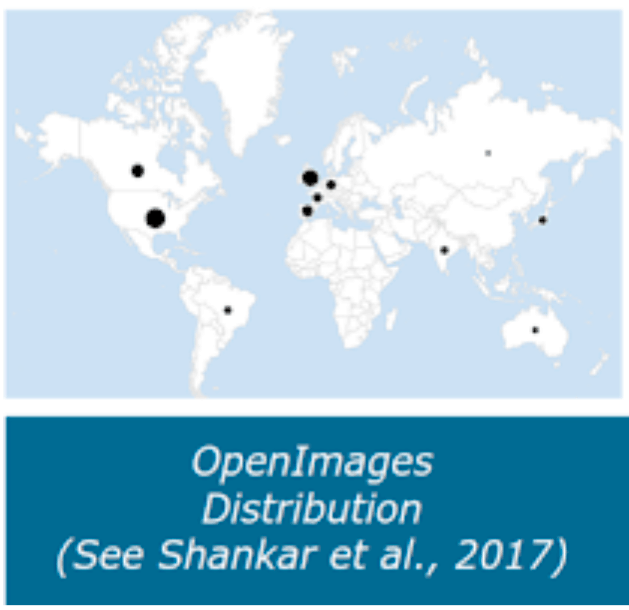
Lack of diversity: “Train data scientists to ask the questions humanities majors ask,” says Hao.
Deepfakes: “Deepfakes are deep learning plus fakes: the abuse of AI,” says Hao.
Expertise: Data scientist Joe Southerland of Search Discover cautions: “Buyer beware. You can’t pick up an #AI black box to evaluate it. It takes a data scientist you can trust.”
Confusing language: Hocking was surprised that “The language around AI confused people.”
Boredom: “80% to 90% of the AI job is boring — sourcing and cleaning data,” says Bhattacharya.
Organizational siloes: “Insights live in silos. Is the business asking marketing for the insights AI can bring?” asks Hocking.
Sometimes “Marketing can’t access data in IT’s control. A centralized traffic cop needs to decide what’s best for the business,” says Bhattacharya.
Now you have an overview of the state of the art in marketing with AI. The field is moving fast, so we’ll update you going forward.
In the meantime, take advantage of these resources to learn about AI in marketing:
AI Marketing Resources
To get educated on AI and marketing, consult these resources:
- AI for Everyone, a free online course from Stanford
- What is AI? from Karen Hao at MIT Technology Review
- The Ultimate Beginners Guide to AI in Marketing from the Marketing Artificial Intelligence Institute
- The book AI for Marketers, An Introduction and Primer, by Christopher S. Penn
- The Marketing Artificial Intelligence newsletter
If you know of additional resources on AI in marketing, please add a comment below. Thanks in advance!
George Stenitzer
George is the Founder and Chief Content Officer at Crystal Clear Communications.


